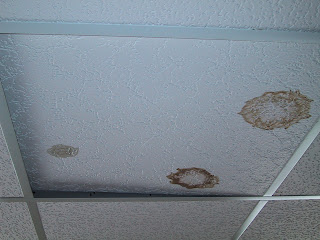You can’t really do away with that stain on the ceiling, leaving you with the next best option of covering it up. Use of stain blocking paint does the trick. The most recognized brand for this purpose is Kilz.

Having had a lot many years of experience in home construction and its renovation, I wouldn’t claim to know everything there is to that, but I do have wide ranging knowledge in the field of remodeling. It’s not too difficult to paint a ceiling provided you prepare the surface well.
At the outset you should cover any surface not needing paint. Make use of painter’s tape at the junction of ceiling and wall or the joint of cornice molding and the ceiling. If you are going to paint your kitchen make sure that you cover all your cabinets. Floor and walls can be covered using throwaway drop cloths.
In case of ceilings with acoustic ceiling tiles, often referred to as drop ceiling, the best option is to replace the stained tiles with new tiles. That way you’ll save a lot of time.
There is bound to be some splattering of paint when you paint using a roller. It may not be visible, but it certainly is there. That makes it necessary to use safety glasses to keep your eyes safe from falling paint while painting. Likewise, you need to use a headgear like a cap or some other cover to prevent paint from falling directly on your head. It’s important to keep kids and pets away while painting.

Different Types Of Paints
It’s very easy to use flat paint. In whatever manner you may use it, it looks the same. There is no need for you to maintain a wet edge while you paint along the ceiling or wall. Even if you miss any spot, it can be touched up later.
It’s quite tough to use glossy paints. You need to maintain a wet edge all the time. Finish the entire ceiling or wall without stopping. Any point needing touching with new paint after the paint has dried will be easily spotted as it will become more glossy than the rest of the surface.
In Conclusion
As already pointed out, painting of suspended ceiling isn’t a very tough job. The hardest part of painting is preparation of the surface. Make sure to cover everything before you really get stated with painting or you’ll end up covering items that needed no paint. Walls can also be painted the same way. It’s not difficult to see that painting of wall is easier as you are not over the entire room as in case of a ceiling.


